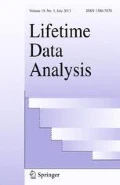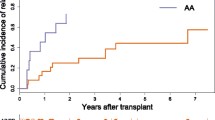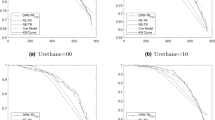Abstract
The aim of this study is to provide an analysis of gap event times under the illness–death model, where some subjects experience “illness” before “death” and others experience only “death.” Which event is more likely to occur first and how the duration of the “illness” influences the “death” event are of interest. Because the occurrence of the second event is subject to dependent censoring, it can lead to bias in the estimation of model parameters. In this work, we generalize the semiparametric mixture models for competing risks data to accommodate the subsequent event and use a copula function to model the dependent structure between the successive events. Under the proposed method, the survival function of the censoring time does not need to be estimated when developing the inference procedure. We incorporate the cause-specific hazard functions with the counting process approach and derive a consistent estimation using the nonparametric maximum likelihood method. Simulations are conducted to demonstrate the performance of the proposed analysis, and its application in a clinical study on chronic myeloid leukemia is reported to illustrate its utility.





Similar content being viewed by others
References
Andersen PK, Borgan Ø, Gill RD, Keiding N (1993) Statistical models based on counting processes. Springer, New York
Bennett S (1983) Analysis of survival data by the proportional odds model. Stat Med 2:273–277
Chang SH (2000) A two-sample comparison for multiple ordered event data. Biometrics 56:183–189
Chang IS, Hsiung CA, Wen CC, Wu YJ, Yang CC (2007) Non-parametric maximum-likelihood estimation in a semiparametric mixture model for competing-risks data. Scand J Stat 34:870–895
Chen L, Lin DY, Zeng D (2012) Checking semiparametric transformation models with censored data. Biostatistics 13:18–31
Chen YH (2009) Weighted Breslow-type and maximum likelihood estimation in semiparametric transformation models. Biometrika 96:591–600
Chen YH (2010) Semiparametric marginal regression analysis for dependent competing risks under an assumed copula. J R Stat Soc Ser B 72:235–251
Chen YH (2012) Maximum likelihood analysis of semicompeting risks data with semiparametric regression model. Lifetime Data Anal 18:36–57
Choi S, Huang X (2014) Maximum likelihood estimation of semiparametric mixture component models for competing risks data. Biometrics 70:588–598
Clayton DG (1978) A model for association in bivariate life tables and its application in epidemiological studies of familial tendency in chronic disease incidence. Biometrika 65:141–151
Cox DG (1972) Regression models and life-tables. J R Stat Soc Ser B 34:187–220
Fine JP (1999) Analysing competing risks data with transformation models. J R Stat Soc Ser B 61:817–830
Frank MJ (1979) On the simultaneous association of \(F(x, y)\) and \(x+y-F(x, y)\). Aequat Math 19:194–226
Gumbel EJ (1960) Distributions des valeurs extremes en plusieurs dimensions. Publ Inst Stat Univ Paris 9:171–173
Hsieh JJ, Wang WJ, Ding AA (2008) Regression analysis based on semicompeting risks data. J R Stat Soc Ser B 70:3–20
Huang Y (2000) Two-sample multistate accelerated sojourn times model. J Am Stat Assoc 95:619–627
Huang Y (2002) Censored regression with the multistate accelerated sojourn times model. J R Stat Soc Ser B 64:17–29
Huang X, Liu L (2007) A joint frailty model for survival and gap times between recurrent events. Biometrics 63:389–397
Huang X, Zhang N (2008) Regression survival analysis with an assumed copula for dependent censoring: a sensitivity analysis approach. Biometrics 64:1090–1099
Huang CH, Chen YH, Chuang YW (2017) Semiparametric regression analysis of recurrent gap times in the presence of competing risks. Stat Sin 27:1059–1077
Lin DY, Sun W, Ying Z (1999) Nonparametric estimation of the gap time distributions for serial events with censored data. Biometrika 86:59–70
Lu W, Peng L (2008) Semiparametric analysis of mixture regression models with competing risks data. Lifetime Data Anal 14:231–252
Peng L, Fine JP (2007) Regression modeling of semicompeting risks data. Biometrics 63:96–108
Prentice RL, Williams BJ, Peterson AV (1981) On the regression analysis of multivariate failure time data. Biometrika 68:373–379
Schaubel DE, Cai J (2004) Regression methods for gap time hazard functions of sequentially ordered multivariate failure time data. Biometrika 91:291–303
Zeng D, Lin DY (2006) Efficient estimation of semiparametric transformation models for counting processes. Biometrika 93:627–640
Zeng D, Lin DY (2007) Maximum likelihood estimation in semiparametric regression models with censored data. J R Stat Soc Ser B 69:507–564
Acknowledgements
The authors are grateful for the helpful comments from an associate editor and two referees. This research was supported by Taiwan Ministry of Science and Technology Grant 104-2118-M-305-003.
Author information
Authors and Affiliations
Corresponding author
Rights and permissions
About this article
Cite this article
Huang, CH. Mixture regression models for the gap time distributions and illness–death processes. Lifetime Data Anal 25, 168–188 (2019). https://doi.org/10.1007/s10985-018-9418-7
Received:
Accepted:
Published:
Issue Date:
DOI: https://doi.org/10.1007/s10985-018-9418-7




